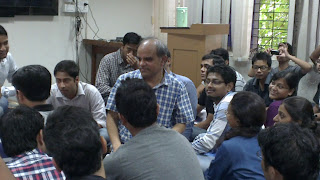Every successful organization today, boasts of its sound management
system. But have we come to realize as to why did the need for
management arise in the first place?
This can be easily explained with the help of a simple activity which was carried out in Dr. Mandi's lecture.
An ideal situation was presented where one had to build a tower by piling small cubes on top of each other. A bidding was done on the maximum number of cubes that could be used to build this tower until it falls. The highest bidder came up with a number of 14 and was instantly put to the task of building the tower. This bidder went on to use a total of 22 cubes before the tower collapsed. Since the stakes were kept low, the bidder obviously got his money back.
Now, in another situation, this task was to be repeated, where the person building the tower would be blindfolded. A team was made consisting of a CEO, a Manager and a simple worker. The job of the worker was to build this tower (with a blindfold). However, he would have assistance from his Manager who would in turn work on a plan put in place by the CEO. Since, the stakes were very high, it was very difficult to find volunteers for this task, but finally we found our team. The bid was made on a tower of 20 blocks. The final result was 23 blocks, with a blindfold.
The first approach of building the tower is symbolic of the old way of running the organization. Here, the bidder was the sole person carrying out the task with all of his options open. He had few or no challenges associated with this task. Also, he had the flexibility of deciding as to how he should use his skill set in carrying out the activity. Dr. Mandi drew an analogy and compared this bidder to a bidi maker who does all the hardwork, alone and without the need of any guidance and management. The nature of work becomes ambiguous since the worker is supposed to take a lot of decisions on his own. Further, the skill set required is massive as one person is carrying out all the work. Also, more time required to carry out this activity.
However, in the second approach, the decision making responsibility is shifted to the manager and the CEO. The worker works with improved productivity since he doesn't have to worry about taking decisions. The onus of performance now lies on the shoulders of the manager who in turn is answerable to the CEO. Also, lesser time is required in this case since the work process is enlarged from Work -> Job -> Activities -> Task -> Elements. When a worker is required to work on the Elements portion of the workspace, he obviously needs a lower skillset.
This is the new approach which is followed in organizations today, around the globe. Since the work process is enlarged in this case, the organizations go in for Management Systems to manage these processes.These sound Management Systems bring out results which are better than the old way and certainly more controllable with lesser dependence on a single individual.
This can be easily explained with the help of a simple activity which was carried out in Dr. Mandi's lecture.
An ideal situation was presented where one had to build a tower by piling small cubes on top of each other. A bidding was done on the maximum number of cubes that could be used to build this tower until it falls. The highest bidder came up with a number of 14 and was instantly put to the task of building the tower. This bidder went on to use a total of 22 cubes before the tower collapsed. Since the stakes were kept low, the bidder obviously got his money back.
Now, in another situation, this task was to be repeated, where the person building the tower would be blindfolded. A team was made consisting of a CEO, a Manager and a simple worker. The job of the worker was to build this tower (with a blindfold). However, he would have assistance from his Manager who would in turn work on a plan put in place by the CEO. Since, the stakes were very high, it was very difficult to find volunteers for this task, but finally we found our team. The bid was made on a tower of 20 blocks. The final result was 23 blocks, with a blindfold.
The first approach of building the tower is symbolic of the old way of running the organization. Here, the bidder was the sole person carrying out the task with all of his options open. He had few or no challenges associated with this task. Also, he had the flexibility of deciding as to how he should use his skill set in carrying out the activity. Dr. Mandi drew an analogy and compared this bidder to a bidi maker who does all the hardwork, alone and without the need of any guidance and management. The nature of work becomes ambiguous since the worker is supposed to take a lot of decisions on his own. Further, the skill set required is massive as one person is carrying out all the work. Also, more time required to carry out this activity.
However, in the second approach, the decision making responsibility is shifted to the manager and the CEO. The worker works with improved productivity since he doesn't have to worry about taking decisions. The onus of performance now lies on the shoulders of the manager who in turn is answerable to the CEO. Also, lesser time is required in this case since the work process is enlarged from Work -> Job -> Activities -> Task -> Elements. When a worker is required to work on the Elements portion of the workspace, he obviously needs a lower skillset.
This is the new approach which is followed in organizations today, around the globe. Since the work process is enlarged in this case, the organizations go in for Management Systems to manage these processes.These sound Management Systems bring out results which are better than the old way and certainly more controllable with lesser dependence on a single individual.




